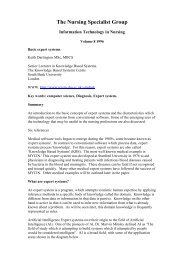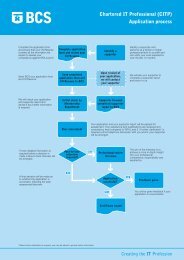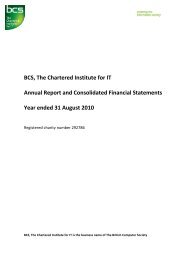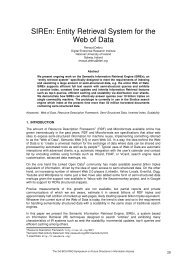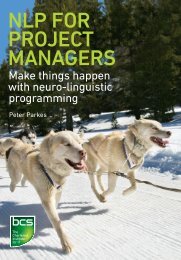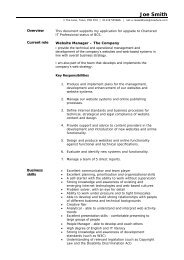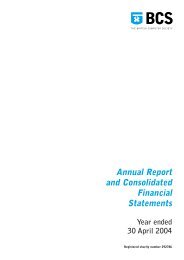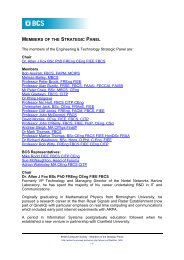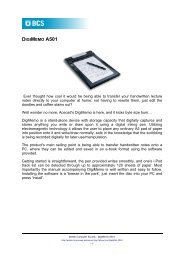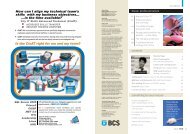Bringing Programming Languages up to Date John Florentin ... - BCS
Bringing Programming Languages up to Date John Florentin ... - BCS
Bringing Programming Languages up to Date John Florentin ... - BCS
Create successful ePaper yourself
Turn your PDF publications into a flip-book with our unique Google optimized e-Paper software.
<strong>Bringing</strong><br />
<strong>Programming</strong> <strong>Languages</strong><br />
<strong>up</strong> <strong>to</strong> <strong>Date</strong><br />
<strong>John</strong> <strong>Florentin</strong> & Geoff Sharman<br />
<strong>BCS</strong> APSG<br />
March 2009
2<br />
Towards New <strong>Languages</strong><br />
● High level languages are the prime <strong>to</strong>ol for<br />
creating system and application software<br />
● Their design can make a major difference <strong>to</strong><br />
the cost, difficulty, and likelihood of success in<br />
implementing business applications<br />
● Computing technology has changed radically<br />
since the first HLL's were introduced, and so<br />
has the business environment<br />
● But the design of languages has not improved<br />
sufficiently nor kept <strong>up</strong> with these changes
3<br />
What we'll Discuss<br />
● What is the problem?<br />
● A brief his<strong>to</strong>ry of programming languages<br />
● The 21 st century computing environment & why<br />
a new model is needed<br />
● Closing thoughts
4<br />
What's the Problem?<br />
● Despite many advances, current programming<br />
languages are often non-intuitive and still<br />
produce programs that are:<br />
– Complex (hard <strong>to</strong> read & understand)<br />
– Error-prone (especially w.r.t. concurrency)<br />
– Brittle (hard <strong>to</strong> change)<br />
– Unmanageable (hard <strong>to</strong> recompile, refac<strong>to</strong>r)
5<br />
What's the Problem? (ii)<br />
● Modern computing environments have:<br />
– Many different types of computing device with a<br />
wide range of form fac<strong>to</strong>rs<br />
– Worldwide high speed networks<br />
– Huge volumes of data<br />
– Applications with many concurrent users<br />
● But languages do not enable programmers <strong>to</strong><br />
exploit these environments easily<br />
– S<strong>up</strong>port only via libraries and/or subsystems<br />
– Many applications fail <strong>to</strong> scale
A Brief His<strong>to</strong>ry of <strong>Programming</strong> <strong>Languages</strong>
7<br />
Machine <strong>Languages</strong><br />
● Widely used in 1950s - 1960s<br />
● Programmer aware of hardware architecture:<br />
– Operation codes for program steps<br />
– Addressing scheme<br />
– Real memory addresses for data<br />
– Character encoding<br />
● Programs limited <strong>to</strong> a specific architecture and<br />
physical realisation<br />
– Not portable beyond single machine
8<br />
Assembler <strong>Languages</strong><br />
● Widely used in 1960s – 1970s<br />
● Programmer less aware of hardware<br />
architecture:<br />
– Symbolic names for instructions<br />
– Symbolic names for data items<br />
– Multi-pass assembly for resolution of names<br />
– Assistance with addressing scheme<br />
● Programs limited <strong>to</strong> specific architecture<br />
– Portable between different physical machines
9<br />
High Level <strong>Languages</strong><br />
● Introduced with FORTRAN (1953), LISP (1958),<br />
COBOL (1959) and ALGOL (1960)<br />
● Programmer aware of an “abstract machine”:<br />
– Reserved names for program statements and<br />
control structures, e.g. loops<br />
– Symbolic names for data items and data structures,<br />
e.g. arrays, records<br />
– Basic input/output facilities<br />
– Multi-pass compilation, large/virtual memory<br />
● Programs portable between h/w architectures<br />
– Separate compilation for modular programs
10<br />
The HLL Abstract Machine<br />
● HLL programs run as batch jobs:<br />
– Programs typically processed sequential data files,<br />
which were owned for the duration of the job<br />
● e.g. Master file/transaction file <strong>up</strong>date<br />
● Operating system handles resource allocation,<br />
job scheduling, print spooling and virtual<br />
memory management<br />
– Consolidated as the “process abstraction”<br />
– Normally with a single thread of execution<br />
● Many programs still in use (aka “legacy”)
11<br />
Transaction/Data <strong>Languages</strong><br />
● From 1960s & 1970s online applications<br />
became common, e.g. airline reservation<br />
systems, retail banking, point of sale:<br />
– Networks of terminals attached <strong>to</strong> a central server<br />
– Fast response required for cus<strong>to</strong>mer requests<br />
– Direct access <strong>to</strong> individual records rather than files<br />
● S<strong>up</strong>ported by the development of database<br />
managers and transaction processing moni<strong>to</strong>rs<br />
– Functionality accessed via “sublanguages”, e.g.<br />
CICS Command Level (1974) and SQL(1978)<br />
– Embedded in subset of HLL
The OLTP Abstract Machine<br />
● Online programs are initiated via a message<br />
and produce a reply message within seconds<br />
● The TP moni<strong>to</strong>r and DB manager provide:<br />
– rapid dispatching via pre-allocated resources,<br />
– efficient concurrent execution<br />
– distribution over multiple processors<br />
– record level data access and other services<br />
● Consolidated as the “transaction abstraction”<br />
– Individual transactions usually single threaded<br />
● OLTP s<strong>up</strong>ports most consumer transactions<br />
<strong>to</strong>day<br />
12
13<br />
The C Language<br />
● C (1972) was developed as the systems<br />
programming language for Unix<br />
– Derived from ALGOL via BCPL<br />
– Minimal language but includes key HLL features<br />
– Efficient execution, replacing assembler language<br />
– Also adopted for applications<br />
– Programs somewhat portable between Unix systems<br />
● Still ranked as the “most popular” programming<br />
language
14<br />
The C Abstract Machine<br />
● C uses an HLL abstract machine for interactive<br />
programs, rather than batch<br />
● Its de fac<strong>to</strong> abstract machine contains HLL plus<br />
Unix features:<br />
– User interaction<br />
– Hierarchical file system<br />
– Network communication, client/server access<br />
– Threading<br />
● Adapted for PCs and many subsequent devices
15<br />
Object Oriented <strong>Languages</strong><br />
● Smalltalk (1970s) was developed as a language<br />
for robust programming<br />
– Derived from ALGOL via Simula 67<br />
– Models an application domain via classes & objects<br />
– Provides encapsulation, polymorphism, inheritance<br />
● OO features later incorporated in C++, Java etc.<br />
– From 1990s, used <strong>to</strong> implement graphical user<br />
interfaces on personal workstations<br />
– Programs somewhat portable<br />
– Java, C++ also ranked as “very popular” languages
16<br />
The OO Abstract Machine<br />
● OO uses a modified form of the C abstract<br />
machine<br />
– C++ provides <strong>up</strong>wards compatibility from C<br />
– S<strong>up</strong>ported by Standard Template Library for<br />
extended data structures and algorithms<br />
– Java abstracts as the Java Virtual Machine (JVM)<br />
– JSRs define extensive libraries for GUI, forms,<br />
communications, database access, etc.<br />
● Fully encapsulated memory management is<br />
one of its important advantages
17<br />
Functional <strong>Languages</strong><br />
● LISP was developed as language based on<br />
Lambda Calculus<br />
– Data structures based on lists and trees<br />
– Operations on lists, no loops<br />
– Dynamic typing<br />
– Modifiable program source code<br />
● Focus on concise and provable programs<br />
– Later FLs include ML, Miranda, Haskell<br />
– Single assignment or no assignment<br />
– Influential but never mainstream
18<br />
The FL Abstract Machine<br />
● Because FLs are primarily designed for<br />
mathematical computation, they are usually<br />
employed in a single user context<br />
– e.g. complex analysis, derivatives trading<br />
● Their de fac<strong>to</strong> abstract machine is very similar<br />
<strong>to</strong> that of HLL programs<br />
– Attempt <strong>to</strong> abstract from procedural semantic<br />
– Operating system process with few extra facilities<br />
– Little recognition of interactive user interfaces,<br />
networking,databases etc.
The 21 st Century <strong>Programming</strong> Environment<br />
Why a New Model is Needed
Pervasive Computing<br />
● Steadily decreasing cost of computing has<br />
enabled computing systems with a wide range<br />
of form fac<strong>to</strong>rs:<br />
– RFID tags, smart cards<br />
– Embedded domestic systems<br />
– Handheld systems (mobile phones etc.)<br />
– Personal workstations<br />
– Enterprise servers<br />
– Embedded commercial/industrial systems<br />
– Warehouse-sized computers<br />
20●<br />
Average home has < 100 digital devices
21<br />
Standalone Applications<br />
● Many computing devices s<strong>up</strong>port an operating<br />
system and a few pre-loaded applications with<br />
a simple user interface<br />
● For this class of devices:<br />
– C programming is the best fit. It's likely <strong>to</strong> be<br />
chosen for cost reasons – especially at the low end<br />
● These applications will probably have obvious<br />
bugs and vulnerabilities<br />
– In standalone devices, it may not matter (much)
22<br />
Networked Configurations<br />
1980s<br />
~ 1000 active terminals<br />
9.6 kbps network<br />
1 MIPS processor<br />
10 megabytes memory<br />
2000s<br />
~ 100k – 1 million active devices<br />
100 mbps Ethernet<br />
Broadband Internet<br />
1 gigahertz processor(s)<br />
1 terabyte memory<br />
Most servers are clusters with shared data<br />
Over this period:<br />
Processors improved by a fac<strong>to</strong>r of 1000 (Moore's Law)<br />
Memory improved by a fac<strong>to</strong>r of 5,000<br />
Networks improved by a fac<strong>to</strong>r of 10,000<br />
Average person probably does 10 - 100 transactions/day
23<br />
Applications for User Devices<br />
● Rapid growth in end user devices:<br />
– Personal workstations<br />
● $10 lap<strong>to</strong>p project in India<br />
– Handheld systems<br />
● Latest devices offer voice, music, image, text, etc.<br />
● Established programming techniques:<br />
– OO programming well unders<strong>to</strong>od for GUI<br />
– But complex user interfaces limit acceptance<br />
● Web browser may become the base for new<br />
applications: [how will programming change?]<br />
– e.g. Google Chrome
24<br />
Warehouse Sized Servers ...<br />
Build a cluster of cheap machines<br />
Thousands of cus<strong>to</strong>m designed PC boards<br />
Running Linux<br />
With lots of disc space<br />
Linked by a very fast network<br />
This is actually used by Google ...<br />
Power consumption?<br />
Cooling?<br />
Systems<br />
Management?<br />
How do we write applications <strong>to</strong> exploit this?<br />
100+ mbps<br />
network
25<br />
Applications for Servers<br />
● Internet use growing rapidly due <strong>to</strong><br />
widespread adoption of broadband:<br />
– Web servers now s<strong>up</strong>port large populations of concurrently<br />
active end users & many new applications<br />
– OLTP model suited <strong>to</strong> this workload and already adopted by<br />
web servers for static information<br />
– “Cloud computing” expected <strong>to</strong> be the future<br />
● But applications still have many challenges:<br />
– Achieving scalability with large server clusters & networks<br />
– Accessing/processing large shared databases<br />
– Dealing with systems management issues<br />
– Achieving very low error rates
26<br />
Problem Statement - Refined<br />
● We don't yet have an effective model for server<br />
applications in the Internet era. We need <strong>to</strong>:<br />
– Exploit concurrency and parallelism, free of infrastructure<br />
concerns<br />
– Enable change as rapidly as needed for business reasons<br />
– Achieve a high degree of correctness without extensive testing<br />
● We need a new abstract machine, based on<br />
the OLTP model, adding the best of OO and FL<br />
– Au<strong>to</strong>matically provides concurrency<br />
– With programmable functionality c.f. AOP/AOSD<br />
– Basis for new languages which exploit it<br />
– “Container” concept in Java EE provides an example
27<br />
Abstract Machine = Middleware<br />
application pgms<br />
middleware<br />
database comms<br />
operating system<br />
hypervisor layer<br />
server hardware<br />
Middleware Layer exploits database and comms<br />
layer as well as operating system<br />
Provides virtualisation: applications portable if<br />
only middleware services used
28<br />
Middleware may Span Clusters<br />
applications<br />
middleware<br />
operating system<br />
Middleware layer:<br />
applications<br />
layer<br />
operating system<br />
server hardware server hardware<br />
May exist on multiple physical systems, different<br />
operating systems or hardware architecture:<br />
A multi-system virtual environment<br />
May have a longer lifetime than any one system<br />
Provides a higher level of abstraction than OS –<br />
<strong>to</strong> make application programming easier
29<br />
Client<br />
proxy<br />
Example: Java EE Runtime<br />
RMI/IIOP<br />
Application Server<br />
EJBObject<br />
Container<br />
transactions<br />
security<br />
persistence<br />
etc.<br />
Container + JVM provides:<br />
- runtime environment for Enterprise Java Beans<br />
- creation & destruction of EJBs (lifecycle)<br />
- additional services mapped <strong>to</strong> local interfaces<br />
EJB<br />
EJB JAR File<br />
Java<br />
Classes<br />
deployment<br />
descrip<strong>to</strong>r<br />
- common execution semantic for multiple environments<br />
But what if we need <strong>to</strong> add <strong>to</strong>/change its functionality?<br />
Session Beans<br />
Message Driven<br />
Beans<br />
Entity Classes<br />
other<br />
enterprise<br />
beans<br />
E.g.. Transaction<br />
enabled<br />
- requires<br />
- s<strong>up</strong>ports<br />
- requires new<br />
- manda<strong>to</strong>ry<br />
- bean managed
30<br />
Towards a New Model<br />
● The new abstract machine should provide:<br />
– Better modularity, enabling flexibility <strong>to</strong> respond <strong>to</strong><br />
business change [cf. “cell” concept in Erasmus]<br />
– Parallelism, enabling faster response <strong>to</strong> user<br />
requests [cf. OCCAM, Erasmus, etc.]<br />
– Loose co<strong>up</strong>ling, enabling asynchronous operation<br />
[cf. MQSeries messaging, JMS]<br />
– Better integration with database managers,<br />
avoiding the “impedance mismatch” problem<br />
[cf. Functional database/language unification]<br />
– Robust scripting, enabling us <strong>to</strong> represent long<br />
lived business processes [cf. BPEL, CICS BTS]
Closing Thoughts
32<br />
Future Work<br />
● We haven't talked about:<br />
– Declarative vs. imperative languages<br />
– Dynamic vs. static type checking<br />
– Bytecode interpretation, JIT compilation<br />
– Managing multiple versions of modules/programs<br />
– The role of metalanguages<br />
– Features for data mining, grid computing, etc.<br />
● All these things should be considered by any<br />
language designed for a new abstract machine
33<br />
Expanded Role of the IDE<br />
● IDEs (e.g. Eclipse) are widely used <strong>to</strong> enable<br />
interactive editing, syntax checking,<br />
compilation, debug etc.<br />
● But should be extended <strong>to</strong> s<strong>up</strong>port:<br />
– Alternative syntactic forms<br />
– Subassembly build based on new modular forms<br />
– Debug with simulated data, in simulated time<br />
– Performance modelling<br />
– Etc.




